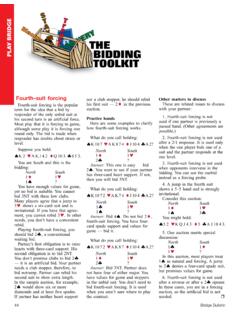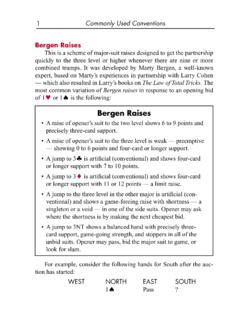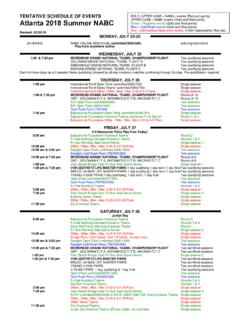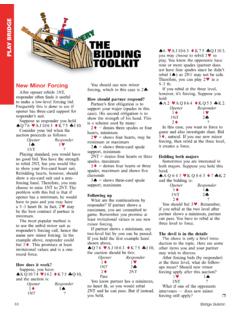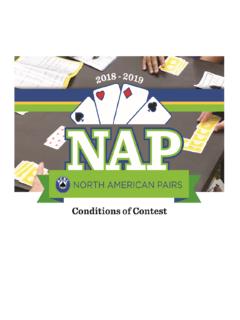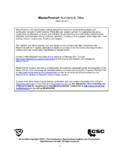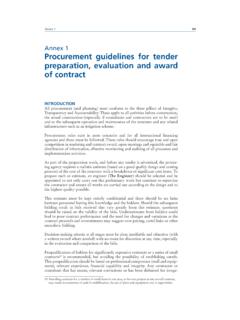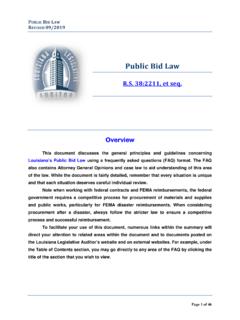Transcription of PLAY BRIDGE - ACBL
1 Responding to a takeout doubleThe use of a low-level double is arequest to partner to bid an unbid suit. The most common instance is after a one-level bid by an oppo-nent. The double normally indicates a hand worth an opening bid with at least three-card support for all unbid suits. Knowing the proper responses after partner doubles is crucial. You should look first to play in one of the major suits. The second choice is notrump. If either of these is not a good option, then you should play in a minor the bidding is: West North East South 1 Dbl Pass ?Partner is asking you to bid. How do you respond?1. Make a minimum suit response with 0 8 high-card points. Suppose you hold this hand and the bidding has proceeded as above (all the following examples presume left-hand opponent opened 1 and partner doubled and RHO passes): K 10 4 3 Q 4 10 4 3 J 7 6 4 With this hand, you should respond 1.
2 You are lucky to have a useful hand, but you are not strong enough to do more than bid at the one level. Notice that you would also have to bid 1 with: 10 8 4 3 Q 4 10 4 3 J 7 6 1 doesn t promise values since partner forced you to Bid 1NT with a relatively balanced hand and 7 10 HCP. Here is an example: K 10 3 Q 4 Q 10 4 3 J 7 5 7 10 HCP is recom-mended here, the exact strength is a matter of style, and expert opinions vary. The conservative view is to use the bid for 7 10 or 8 10, but others recommend 6 9 or even 5 10. As with many bidding situ-ations, this is something you and your partner should Make a jump response in your suit with 9 11 HCP, or a good 8 HCP and some distribution.
3 Suppose you hold: K 10 3 Q J 7 4 3 10 4 3 A should not bid 1 you are too strong. You should jump to 2 , a bid that is invitational. Partner can pass if he has a minimum takeout double. If he has 13 points and you have 10, that s not enough for game. If he has extra, he can bid Bid 2NT with 11 to 12 HCP and at least one stopper in the opponent s suit. With this hand: A 3 J 5 3 K Q 10 4 J 10 7 4,you should bid 2NT. The hand is too strong for 1NT and you don t have a four-card or longer major. Try to play notrump instead of a minor suit when you have a hand this strong. 2NT shows your strength and approximate pattern and allows partner to make a good Cuebid the opponent s suit with 12 or more HCP.
4 If you and partner both have opening bid values, you probably have game. You send this message to partner with a cuebid. Suppose you have: A 6 Q J 5 3 K Q 7 4 J 10 5 you play game in 3NT or 4 ? If partner has a four-card heart suit, you would want to play 4 . If partner only has three-card heart support, then you want to play 3NT. Since you are not sure, cuebid 2 . If partner rebids 2 , you can raise to 4 . If partner bids something else, you can bid Jump to the three-level with a long suit with good playing strength, but less than game values. You hold: K J 10 8 7 4 9 5 4 Q 10 9 3 . Your hand has too much potential for a simple 1 bid, but doesn t qualify for a 2 bid with only 6 HCP.
5 Bidding one more than a single jump shows you have a long suit and some useful points. Partner can evaluate his hand to decide whether to continue to 4 .Here are some more examples. In each case, suppose your LHO opens 1 and partner doubles. Example #1: 8 5 3 K Q 3 9 4 3 2 7 4 3?Answer: Bid 1 . Yes, your suit is weak, but you are forced to bid and it s the only four-card suit you #2: 8 4 Q 8 4 3 10 8 3 A K 4 : Bid 2 . It s true your hearts are only four cards long and not very strong, but bidding 1 does not show the strength of your hand. Partner usually has four-card heart support, so jump to 2 and hope for the #3: 10 7 K 8 3 K Q J 10 7 9 7 : Bid 2 . You don t have a four-card major to bid.
6 You don t have a club stopper. That leaves bidding diamonds. Jumping to 2 promises diamonds and 9 11 (or a good 8) points, which is a good description of your hand. r44 BRIDGE BulletinPLAY BRIDGE

